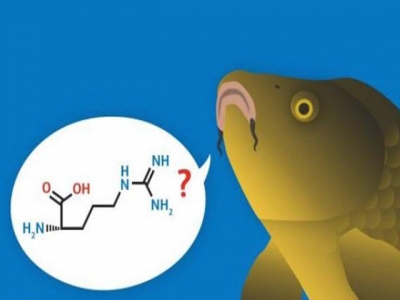Method developed to protect carp from ammonia

Adding arginine to fish diets may reduce fish mortality due to ammonia exposure.
Veterinarians from RUDN University have developed a way to increase the resistance of carp, the most common fish in fish farms, to the harmful effects of ammonia, which is found in almost all water bodies.
Veterinarians from RUDN University in Moscow, Russia, have developed a way to increase the resistance of carp one of the most common fish raised in fish farms to the harmful effects of ammonia, which is found in almost all water bodies.
The researchers found that the amino acid arginine can be helpful if added to fish food, RUDN said in its announcement. The article was published in the journal Aquaculture
One of the main problems of fish farms is water pollution from ammonia, which enters water bodies from wastewater treatment plants, from livestock farms and from fields where nitrogen fertilizers are used, RUDN said. Ammonia reduces the ability of hemoglobin to bind oxygen, acts on the nervous system, affects red blood cells and can lead to fish death, the university added.
Yuri Vatnikov, director of the department of veterinary medicine at RUDN University, and his colleagues have developed a way to use feed additives to increase the resistance to ammonia in common carp, a species that is of great economic importance, as fish farms sell about 4 million tons of carp per year, according to the U.N. Food & Agriculture Organization (FAO), the announcement said.
The veterinarians conducted two experiments in which they examined the effect of arginine, an amino acid that stimulates the release of growth hormone.
In the first experiment, 600 carp were distributed in four tanks and kept for 10 days to allow the fish to adapt to the new conditions. For the next two weeks, the fish in each tank were fed one of four feeding options: with the addition of arginine in the proportion of 0.25%, 0.5% or 1% by weight of food and a control group without the addition of arginine.
Subsequently, the fish from each tank were redistributed to fifteen 30-liter aquariums containing 10 fish each. An ammonia solution was then added to the water for three hours at concentrations of 0.7, 0.8, 0.9, 1.1 and 1.3 mg per liter. Finally, the water was vented, and the condition of the fish was assessed.
In the second experiment, 60 carp were distributed into six aquariums and allowed two weeks of acclimatization. For the next 14 days, half of the fish were fed food to which no arginine was added, and the other half were on a diet that included 0.5% arginine. Then, an ammonia solution concentration of 0.7 mg per liter was added to all tanks. After three hours of exposure to ammonia, the researchers took blood samples from the carp for analysis.
According to the announcement, in the first experiment, the fish exposed to an aqueous ammonia solution concentration of 0.7 mg per liter survived, regardless of the type of diet. An increase in the dose of ammonia led to the death of some carp, and with the maximum ammonia concentration of 1.3 mg, all fish died. In the group where arginine supplementation was 0.25%, mortality was 5-10% lower, RUDN said. With an increase in the dose of arginine to 0.5%, mortality decreased even more significantly, by about 35%.
The purpose of the second experiment was to study fish blood samples. Exposure to ammonia reduced the content of amino acids — which play an important role in the formation of urea — particularly the amino acids ornithine and citrulline, the researchers said. The addition of arginine increased the production of amino acids, which enhanced the processing of ammonia into urea. Thus, excess ammonia was excreted from the body.
The problem of the toxic effects of ammonia is of great importance in aquaculture, RUDN said, explaining that fish farmers are interested in ways to suppress the side effects of ammonia. The new study offers a working method based on dietary manipulations: The addition of just 0.5% arginine to the carp food reduces fish mortality from exposure to ammonia by 35%.
The additive activates detoxification — i.e., turning ammonia into urea — and suppresses oxidative stress caused by exposure to ammonia, the researchers concluded.
Source: RUDN University, which is solely responsible for the information provided and is wholly owned by the source. Informa Business Media and all its subsidiaries are not responsible for any of the content contained in this information asset.
Có thể bạn quan tâm
 Sorted: how to improve salmon growth rates by over 5 percents
Sorted: how to improve salmon growth rates by over 5 percents A company that uses a pioneering egg-sorting system to guarantee at least a five percent improvement in growth rates, as well as improvements in feed efficiency
 New Viruses Found in Farmed and Wild Salmon
New Viruses Found in Farmed and Wild Salmon Scientists will now research whether these viruses are passing between farmed and wild fish.
 Preventing and controlling salmon lice in commercial aquaculture
Preventing and controlling salmon lice in commercial aquaculture A cohort study of commercial salmon farms in Norway explores different prevention and treatment strategies for salmon lice and finds that habituated cleaner